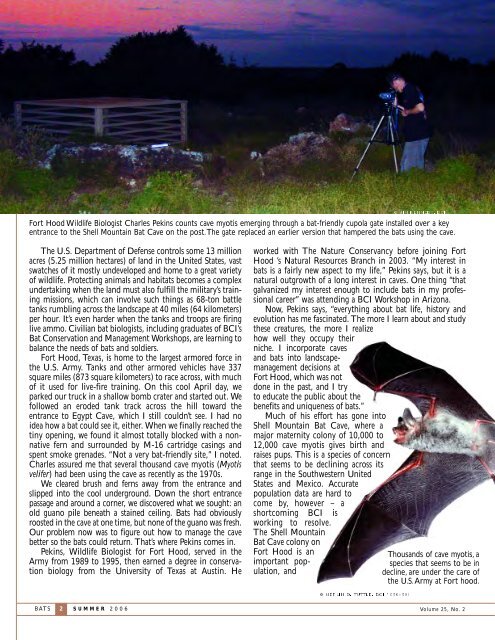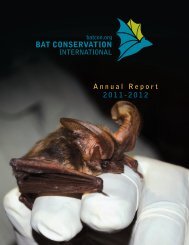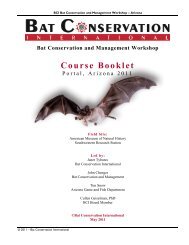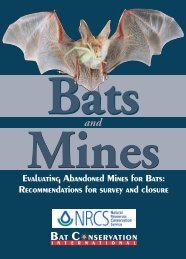OLD BATS OLD BATS - Bat Conservation International
OLD BATS OLD BATS - Bat Conservation International
OLD BATS OLD BATS - Bat Conservation International
Create successful ePaper yourself
Turn your PDF publications into a flip-book with our unique Google optimized e-Paper software.
© JIM KENNEDY, BCI<br />
Fort Hood Wildlife Biologist Charles Pekins counts cave myotis emerging through a bat-friendly cupola gate installed over a key<br />
entrance to the Shell Mountain <strong>Bat</strong> Cave on the post.The gate replaced an earlier version that hampered the bats using the cave.<br />
The U.S. Department of Defense controls some 13 million<br />
acres (5.25 million hectares) of land in the United States, vast<br />
swatches of it mostly undeveloped and home to a great variety<br />
of wildlife. Protecting animals and habitats becomes a complex<br />
undertaking when the land must also fulfill the military’s training<br />
missions, which can involve such things as 68-ton battle<br />
tanks rumbling across the landscape at 40 miles (64 kilometers)<br />
per hour. It’s even harder when the tanks and troops are firing<br />
live ammo. Civilian bat biologists, including graduates of BCI’s<br />
<strong>Bat</strong> <strong>Conservation</strong> and Management Workshops, are learning to<br />
balance the needs of bats and soldiers.<br />
Fort Hood, Texas, is home to the largest armored force in<br />
the U.S. Army. Tanks and other armored vehicles have 337<br />
square miles (873 square kilometers) to race across, with much<br />
of it used for live-fire training. On this cool April day, we<br />
parked our truck in a shallow bomb crater and started out. We<br />
followed an eroded tank track across the hill toward the<br />
entrance to Egypt Cave, which I still couldn’t see. I had no<br />
idea how a bat could see it, either. When we finally reached the<br />
tiny opening, we found it almost totally blocked with a nonnative<br />
fern and surrounded by M-16 cartridge casings and<br />
spent smoke grenades. “Not a very bat-friendly site,” I noted.<br />
Charles assured me that several thousand cave myotis (Myotis<br />
velifer) had been using the cave as recently as the 1970s.<br />
We cleared brush and ferns away from the entrance and<br />
slipped into the cool underground. Down the short entrance<br />
passage and around a corner, we discovered what we sought: an<br />
old guano pile beneath a stained ceiling. <strong>Bat</strong>s had obviously<br />
roosted in the cave at one time, but none of the guano was fresh.<br />
Our problem now was to figure out how to manage the cave<br />
better so the bats could return. That’s where Pekins comes in.<br />
Pekins, Wildlife Biologist for Fort Hood, served in the<br />
Army from 1989 to 1995, then earned a degree in conservation<br />
biology from the University of Texas at Austin. He<br />
<strong>BATS</strong> 2 SUMMER 2006<br />
worked with The Nature Conservancy before joining Fort<br />
Hood ’s Natural Resources Branch in 2003. “My interest in<br />
bats is a fairly new aspect to my life,” Pekins says, but it is a<br />
natural outgrowth of a long interest in caves. One thing “that<br />
galvanized my interest enough to include bats in my professional<br />
career” was attending a BCI Workshop in Arizona.<br />
Now, Pekins says, “everything about bat life, history and<br />
evolution has me fascinated. The more I learn about and study<br />
these creatures, the more I realize<br />
how well they occupy their<br />
niche. I incorporate caves<br />
and bats into landscapemanagement<br />
decisions at<br />
Fort Hood, which was not<br />
done in the past, and I try<br />
to educate the public about the<br />
benefits and uniqueness of bats.”<br />
Much of his effort has gone into<br />
Shell Mountain <strong>Bat</strong> Cave, where a<br />
major maternity colony of 10,000 to<br />
12,000 cave myotis gives birth and<br />
raises pups. This is a species of concern<br />
that seems to be declining across its<br />
range in the Southwestern United<br />
States and Mexico. Accurate<br />
population data are hard to<br />
come by, however – a<br />
shortcoming BCI is<br />
working to resolve.<br />
The Shell Mountain<br />
<strong>Bat</strong> Cave colony on<br />
Fort Hood is an<br />
important population,<br />
and<br />
© MERLIN D. TUTTLE, BCI / 8564501<br />
Thousands of cave myotis, a<br />
species that seems to be in<br />
decline, are under the care of<br />
the U.S.Army at Fort hood.<br />
Volume 25, No. 2

















